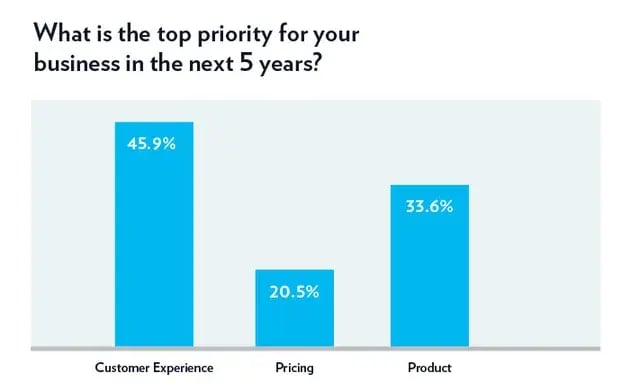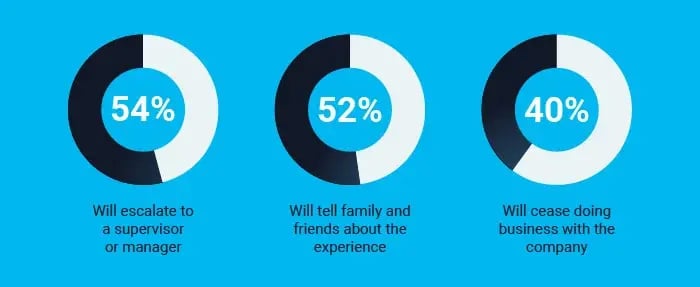- Blog
- The ultimate list of customer service statistics
The ultimate list of customer service statistics
In the ever-evolving business landscape, digital transformation (DX) has garnered immense attention, driven by the need for competitiveness in a digital era. Amidst this, the spotlight has turned to customer experience (CX) as a pivotal factor.
The contemporary business world acknowledges that CX stands as a linchpin for success, leading to unprecedented investments. According to the Global State of CX 2024 report1, 55% of surveyed businesses say growing the customer base is a top strategic CX aim.

This blog delves into the realm of CX metrics, explores the potential of outsourcing and examines technological trends shaping CX and the broader business process outsourcing (BPO) sector. Through compelling statistics and insights, this blog highlights CX's central role in shaping modern business strategies.
With that in mind, companies are investing in CX like never before. When CRM provider SuperOffice asked almost 2,000 business professionals to share their number one priority for the next five years, almost half nominated customer experience2. This trend continues, with the Global State of CX 2024 report showing that 66% of respondents are facing increasing pressure to prove ROI on CX initiatives1.

Source: www.superoffice.com/blog/customer-experience-statistics/
They know that a positive customer experience is good for business and that’s because happy customers spend more money.
When PWC surveyed 15,000 people across 12 countries they found 73% of consumers believe CX is an important factor in their purchasing decisions3. In terms of dollars and cents, 43% of respondents said they would pay more for greater convenience and 42% would pay more for friendly, welcoming customer service. The power of CX was further reinforced by PWC’s finding that 65% of US customers find a positive experience with a brand to be more influential than great advertising.

Source: Experience is everything: Here’s how to get it right (pwc.com)
Such numbers are just the tip of the iceberg when it comes to highlighting how important CX is in the current business environment. Coupled with statistics that reinforce the benefits to be gained from outsourcing, we have compiled a wealth of data from trusted sources to show why there has never been a more important time to focus on customer experience – and how you can deliver it.
The power of CX
At its core, customer experience is a consumer's perception of how a company treats them. Do CX well and there is the opportunity for customers to feel loyalty towards a brand, keep doing business with you and recommend your services to others. Do CX poorly and there is every chance they will never return – and tell others why.
The 2024 Global State of CX1 report highlights why CX has never been a greater focus for businesses:
- 56% of respondents strongly agreed that customers will switch brands when unsatisfied
- 55% said growing the customer base is a top strategic CX aim for 2024
- 50% of respondents strongly agreed that automation is critical for delivering CX at scale
- 55% strongly agreed that data privacy and security is becoming more important to customers.
The harsh reality is that customer expectations continue to rise. The report found that:
- 59% of practitioners said customer demand for convenience was a top behaviour influencing CX planning
- 52% cited customer expectation for instant service or delivery as a key factor
- 38% noted increased customer awareness of how AI works and uses their data
- 31% reported customers are using AI for their own service interactions.
However, organisations that excel at CX are seeing tangible benefits:
- 28% of respondents have noted customer loyalty benefits from generative AI
- 39% reported positive impacts on company profits from generative AI
- 45% saw positive loyalty outcomes from journey orchestration
- 40% experienced positive financial outcomes from journey orchestration
To meet rising expectations, practitioners are focusing on:
- Data and analytics (42% cite as a top trend)
- AI technologies for operations (39%)
- Automation (37%)
- Self-service capabilities.
The report makes clear that CX has become a critical business driver. As one practitioner stated: “we need to demonstrate and validate that CX is critical to business growth and development and can provide not only revenue increases, but also deliver efficiencies that result in reduced operating costs."
With new AI-powered tools emerging, there are more opportunities than ever for organisations to elevate their CX and reap the rewards of customer loyalty and advocacy. However, practitioners must also navigate challenges around proving ROI, managing multiple priorities and responsibly implementing new technologies to build and maintain customer trust.
CX statistics
The importance of CX in business
- 80% of marketers expected to be competing mostly or completely on the basis of CX by 2020, whereas,10 years earlier, it was 36% lower
- 68% of CX experts strongly believe that expectations from customers are rising, while 43% consider customers more impatient than ever before
- 47% of CX executives believe it is getting harder to please customers and more than 50% accept that consumers are more willing than ever to switch brands if unsatisfied
- The number one priority for the 49.5% of business professionals over the next 5 years is customer experience
- 73% of consumers believe CX is an important factor in their purchasing decisions
- 43% of respondents said they would pay more for greater convenience and 42% would pay more for friendly, welcoming customer service
- 24% of businesses said that outsourcing CX has allowed them to manage more projects while maintaining clarity, quality and a fresh state of mind.
The impact of bad CX
- 39% of consumers say the most infuriating aspect of a bad customer service experience is long hold/wait times while another 39% believe it to be a misuse of data in mass-marketing
- 56% of consumers who suffer a bad customer experience claim they will never use the company again and 25% will not recommend the business to friends
- 20% of consumers will take “revenge” by posting a review online and 14% will share a poor experience on social media
- U.S. businesses annually lose an estimated $83 billion due to poor customer service
- 54% of consumers will escalate poor CX to a supervisor or manager, 52% will tell family or friends about the bad experience and 40% will cease doing business with the company.
The effects of good CX
- 65% of US customers find a positive experience with a brand to be more influential than great advertising
- 96% of consumers say a good customer experience over messaging channels is at least somewhat important to their brand loyalty
- 5% of consumers would be more favourable to a brand if it notified them of a service issue proactively but 22% of these consumers have never experienced this before
- 43% of consumers believe the most important aspect of a good customer service experience is support being offered in real-time with the issue being resolved effortlessly
- 49% of consumers feel engagement over their preferred contact channel is the most important aspect of a good customer experience
- 68% of consumers feel brands should know their prior service history in all interactions
- 94% of consumers feel brands should allow customers to provide feedback on their experiences
- Customers who experience positive CX are 54% more likely to make another purchase.
CX metrics
Consulting firm Lee Resource International conducted a study that unearthed a statistic that should send a shiver down the spine of any CX executive – for every customer complaint there are 26 other unhappy customers who remain silent4. It is not good enough to simply wait for customer complaints. Rather, successful organisations actively seek feedback so they can avoid the following outcomes that happen after a poor customer experience:


Customer satisfaction metrics such as NPS, CSAT and CES are vital for ensuring businesses can mitigate such negative feedback that may prove harmful for their bottom line. In fact, increasing NPS and CSAT scores is a top strategic goal for 45% of surveyed organisations1. Here is a brief overview of each:
- Net Promoter Score (NPS) – NPS surveys are short and easy and can be sent during any stage of the customer lifecycle by various survey channels (eg: email, web, text message). The surveys feature a question such as ‘How likely are you to recommend our company to a friend or colleague?’, with respondents using a 0-10 scale (Very Unlikely to Very Likely) and their collective responses resulting in an NPS score. Subsequent open-ended questions (eg: What can we do to improve your customer experience?) can also offer additional insights.
- Customer Satisfaction Score (CSAT) - CSAT surveys are ideally sent when a business wants to find out how happy clients are with an action it took or certain aspects of its products/services (eg: after a client has completed the onboarding process). The surveys normally feature a question asking clients how satisfied they are with an aspect of the brand, with respondents usually answering in the “Very Satisfied – Very Unsatisfied” range. Multiple and open-ended questions can be used in the same survey and the CSAT score is an average based on the results.
- Customer Effort Score (CES) – the CES metric is used to measure customer satisfaction levels by focusing on the effort customers make to interact with a business’s services and products. The idea is for the survey to help determine if customers have a hard time performing certain actions when interacting with the brand and then streamline processes according to the survey data. CES surveys are usually used after a client interacted with customer support, immediately after a customer interacted with a product/service and made a purchase or acquired a subscription, or when a business wants to measure the overall experience consumers have with their products/services.
The benefits of outsourcing your CX
Outsourcing CX, and other roles to a managed operations or BPO provider is an increasingly effective way for organisations to strengthen their CX. The trend towards outsourcing continues, with the Global State of CX 2024 report indicating that 35% of respondents are transitioning to a virtual or hybrid contact centre model1.
The combination of cost reductions and efficiency increases means businesses that outsource are able to dedicate more time and greater staff support to scaling and improving their services and offerings, which is great news for consumers when it comes to CX. Given that, it is little wonder Statistica has projected that revenue in the BPO sector will experience an expected annual growth rate of 6.7% by 2025, reaching an approximate value of US$381,237.4 million5.
Trends in CX
The 2024 Global State of CX report reveals several key trends shaping the industry1:
- AI dominance: AI technologies are at the forefront of CX strategies. Practitioners are leveraging AI for data analysis, operational efficiency and customer interactions. The rise of generative AI is particularly notable, with applications in marketing, personalisation (24%) and customer service chatbots (24%).
- Focus on digital CX components: while overall digital CX has decreased in priority, practitioners are honing in on specific elements. Self-service capabilities are being enhanced to meet customer demands for convenience. Automation is being used to streamline processes and improve efficiency. Data analytics are providing deeper insights into customer behavior and preferences.
- Customer loyalty and employee experience: despite the tech focus, these human-centric aspects remain crucial. Organisations recognise that loyal customers and engaged employees are fundamental to CX success. There's a growing emphasis on creating emotional connections and personalised experiences.
- Disruptive technologies driving results: early adopters of technologies like generative AI and journey orchestration are seeing tangible benefits. 28% report customer loyalty benefits and 39% saw profit gains for gen AI while journey orchestration notes a 45% increase in positive loyalty outcomes with 40% experiencing positive financial impacts. These tools are not only improving customer satisfaction but also positively impacting the bottom line. This success is likely to drive further adoption across the industry.
- Increasing investment in automation: 42% of practitioners plan to invest in automating CX and service functions. Organisations are investing in automating routine tasks to free up human agents for more complex, high-value interactions. This trend is closely tied to the rise of AI and machine learning technologies.
- Data privacy and security: with increased use of customer data comes greater responsibility. 55% of respondents strongly agreed that data privacy and security is becoming more important to customers. Organisations are prioritising data protection to maintain customer trust. This focus on privacy is becoming a differentiator in the market.
- Omnichannel integration: While 16% have fully implemented an omnichannel model, 35% still have fragmented connections between channels. The goal is to provide seamless experiences across all touchpoints, but disjointed systems remain a challenge for many.
- Cloud adoption: 34% of organisations have either fully migrated to cloud contact centres or are cloud-native. The move to cloud-based CX solutions continues, driven by the need for flexibility and scalability. Cloud platforms are enabling more advanced analytics and AI capabilities, as well as supporting remote and hybrid work models.
- Machine customers: a new frontier is emerging with customers using AI assistants for service interactions. This trend is pushing organisations to rethink their service design and prepare for a future where AI interacts with AI.
- ROI pressure: 66% of respondents said the pressure to prove ROI is increasing, while only 1% said it's decreasing. As CX investments grow, so does the pressure to demonstrate returns. Practitioners are focusing on linking CX initiatives to tangible business outcomes, such as increased revenue, reduced costs and improved customer retention.
These trends reflect a CX landscape that is rapidly evolving, driven by technological advancements and changing customer expectations. Organisations that can effectively navigate these trends while maintaining a focus on customer needs are likely to gain a competitive edge.
Reference:
[1] The Global State of CX 2024
[2] 32 Customer experience statistics you need to know for 2024
[3] Experience is everything: Here’s how to get it right
[4] What is the Cost of Poor Customer Service?
[5] Business Process Outsourcing - Worldwide

.jpg)

